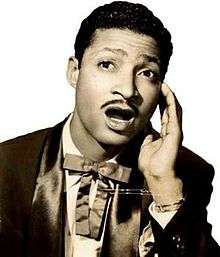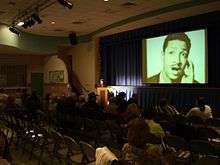Benny Moré
| Benny Moré | |
|---|---|
 | |
| Background information | |
| Birth name | Bartolomé Maximiliano Moré Gutiérrez |
| Born |
24 August 1919 Santa Isabel de las Lajas, Cuba |
| Died |
19 February 1963 (aged 43) Havana, Cuba |
| Genres | Son montuno, mambo, guaracha, bolero, afro |
| Occupation(s) | Musician, bandleader |
| Instruments | Vocals, guitar |
| Years active | 1944–1963 |
| Labels | RCA Victor |
| Associated acts | Conjunto Matamoros, Mariano Mercerón, Bebo Valdés, Ernesto Duarte Brito, Orquesta Aragón, Banda Gigante |
Bartolomé Maximiliano Moré (24 August 1919 – 19 February 1963), known as Benny Moré, was a Cuban singer, bandleader and songwriter. Due to his fluid tenor voice and his great expressivity, he was known variously as El Bárbaro del Ritmo and El Sonero Mayor.[1] Moré was a master of most Cuban popular genres, such as the bolero, son montuno, mambo, and guaracha. Moré formed and led the Banda Gigante, one of the leading Cuban big bands of the 1950s, until his death in 1963.
Early life
The eldest of eighteen children, Benny Moré was born in Santa Isabel de las Lajas in the former province of Las Villas, current Cienfuegos Province, in central Cuba. His maternal great-great grandfather, Ta Ramón Gundo Paredes, was said to be the son of the king of a tribe in the Congo who was captured by slave traders and sold to a Cuban plantation owner (he was later liberated and died as a freeman at age 94). As a child, Moré learned to play the guitar, making his first instrument at age six, according to his mother, out of a board and a ball of string. In 1936, at age seventeen, he left Las Lajas for Havana, where he lived by selling bruised and damaged fruits and vegetables and medicinal herbs. Six months later he returned to Las Lajas and went to cut cane for a season with his brother Teodoro. With the money he earned and Teodoro's savings, he bought his first guitar in Morón.[2]
Career
In 1940, Moré returned to Havana. He lived from hand-to-mouth, playing in bars and cafés, passing the hat. His first breakthrough was winning a radio competition. In the early 1940s, the radio station CMQ had a program called "The Supreme Court of Art" in which a wide variety of artists participated. Winners were given contracts by unscrupulous businessmen who exploited them. The less fortunate were treated to the humiliation of a loud church bell which brutally terminated their performances.[3]
In his first appearance, Moré had scarcely begun to sing when the bell sounded, and was booed off the stage.[3] He later competed again and won first prize. He then landed his first stable job with the Conjunto Cauto led by Mozo Borgellá.[3] He also sang with success on the radio station CMZ with Lázaro Cordero's Sexteto Fígaro. In 1941, he made his debut on Radio Mil Diez performing with the Conjunto Cauto.
Conjunto Matamoros and Mexico
Ciro Rodríguez, of the famed Trío Matamoros, heard Moré singing in the bar El Temple and was greatly impressed. In 1942, Conjunto Matamoros was engaged for a live performance for Radio Mil Diez. However, Miguel Matamoros was indisposed and asked Mozo Borgellá, to lend him a singer. Borguellá sent Moré, who remained several years with the Matamoros, making a number of recordings.[4]
.jpg)
Moré replaced Miguel Matamoros as lead singer, and the latter dedicated himself to leading the band. On 21 June 1945, he went with Conjunto Matamoros to Mexico, where he performed in two of the most famous cabarets: the Montparnasse and the Río Rosa. He made several recordings. Conjunto Matamoros returned to Havana, but Moré remained in Mexico. Rafael Cueto said to him: "Fine, but just remember that they call burros 'bartolo' here. Stay, but change your name." "Ok," replied Moré, "from now on my name is Beny, Beny Moré." Moré was left penniless and got permission to work from the performing artists' union. With this, he was able to get a job at the Río Rosa, where he formed the Dueto Fantasma (also known as Dueto Antillano) with Lalo Montané, in December 1945.[5]
In Mexico City, Moré made recordings for RCA Victor, with Perez Prado: "Bonito y Sabroso", "Mucho Corazón", "Pachito Eché", "La Múcura", "Rabo y Oreja" and other numbers. He recorded "Dolor Karabalí", which Moré considered his best composition recorded with Pérez Prado, one he never wanted to re-record, also his recording in Mexico with Rafael de Paz Orchestra of "Bonito y Sabroso" was never recorded again by Moré, even though his famous composition of the months prior to leaving Mexico became in time the theme of his big band in Cuba. Moré was always reluctant to record newer versions of his hit songs, as he thought "you don't fix what's not broken". Moré and Prado recorded 28 songs in total, mostly mambos.[6]
Moré also recorded with the orchestra of Mariano Mercerón: "Me Voy Pa'l Pueblo", "Desdichado", "Mucho Corazon", "Ensalada de Mambo", "Rumberos de Ayer" and "Encantado de la Vida" with "El Conjunto de Lalo Montane", a Colombian singer and composer, with which he recorded in Mexico, conforming a famous duo called "The Phantom Duet" or "Dueto Fantasma". He also recorded with Mexican orchestras, specially with the one directed by Rafael de Paz; they recorded "Yiri Yiri Bon", "La Culebra", "Mata Siguaraya", "Solamente Una Vez" and "Bonito y Sabroso", a mambo song where he praises the dancing skills of the Mexicans and claims that Mexico City and La Habana are sister cities. In this time Benny also recorded with the orchestra of Jesús "Chucho" Rodríguez. El "Chucho" was so impressed with Benny's musical ability that he referred to him as "El Bárbaro del Ritmo".
Return to Cuba
During the spring of 1952, around April, Moré returned to Cuba. He was a star in Mexico, Panama, Colombia, Brazil and Puerto Rico, but virtually unknown on the island. His first Cuban recordings were with Mariano Mercerón & his Orchestra, including songs like "Fiesta de Tambores", "Salomón", "La Chola", etc. Moré began alternating between performances in the Cadena Oriental radio station and trips to Havana to record at the RCA studios in CMQ Radiocentro.
In Havana, Moré worked for the radio station RHC-Cadena Azul, with the orchestra of Bebo Valdés, who introduced the new style called "batanga". The presenter of the show, Ibraín Urbino, presented him as El Bárbaro del Ritmo. They offered him the opportunity to record with Sonora Matancera, but he declined the offer because he didn't care for the sound of the group. After the batanga fell out of fashion, Moré was contracted by Radio Progreso with the orchestra of Ernesto Duarte Brito. In addition to the radio, he also performed at dances, cabarets and parties. When he sang in Havana's Centro Gallego, people filled the sidewalks and the gardens of the Capitolio to hear him. In 1952, Moré made a recording with the Orquesta Aragón with whom he would perform in dance halls. Orquesta Aragón was from Cienfuegos and was having trouble breaking into Havana and Moré helped them in this way.
La Banda Gigante
The first performance of Moré's Banda Gigante was in the CMQ radio program Cascabeles Candado on August 3, 1953.[7] The original lineup featured Ignacio Cabrera "Cabrerita" (piano); Miguel Franca, Santiago Peñalver, Roberto Barreto, Celso Gómez and Virgilio Vixama (saxophones); Alfredo "Chocolate" Armenteros, Rigoberto "Rabanito" Jiménez and Domingo Corbacho (trumpets); José Miguel Gómez (trombone); Alberto Limonta (double bass); Tabaquito (congas); Clemente Piquero "Chicho" (bongos); Rolando Laserie (drums), and Fernando Álvarez and Enrique Benitez (vocals).[8] The Banda was generally sixteen musicians, comparable in size with the orchestras of Xavier Cugat and Pérez Prado. Although Moré could not read music, he arranged material by singing parts to his arrangers, which included pianists Cabrerita and Peruchín, as well as trombonist Generoso "Tojo" Jiménez.[8]
Between the years 1953 and 1955, the Banda Gigante became immensely popular. In 1956 and 1957, they toured Venezuela, Jamaica, Haiti, Colombia, Panama, Mexico and the United States, where the group played at the Oscar ceremonies. In Havana, they played at a multitude of dance halls and cabarets such as the Tropicana, La Campana, El Sierra, Night and Day, Alí Bar Club, and the hotels Riviera and Habana Libre.[9]
Moré was offered a tour of Europe, France in particular, but he rejected it because of fear of flying (he had by that time been in three air accidents).
Final years
In the aftermath of the Cuban Revolution, many of Cuba's top musical figures emigrated, but Moré stayed in Cuba, among, as he said, "mi gente" (my people).
Moré was an alcoholic, and began to show signs of liver failure in his early 40s. When he died in 1963 of cirrhosis of the liver, an estimated 100,000 fans attended his funeral. He was 43 years old.
Awards and recognition

In 1999, Moré was posthumously inducted into the International Latin Music Hall of Fame. The Benny Moré Memorial Award was named in honor of the artist and was given to artists who were influential in Latin music.[10] On 11 June 2006, Moré was honored with a star on the Walk of Fame at Celia Cruz Park[11] in Union City, New Jersey, a heavily Cuban-American community[12][13][14] that has hosted musical presentations[15] and multimedia lectures on the singer.[16][17]
Moré is remembered in the 2006 film, El Benny, which is based on parts of his life, and includes new versions of his songs performed by musicians including Chucho Valdés, Juan Formell and Orishas.
Selected discography
- Magia antillana (Victor, 1956)
- Pare... que llegó el bárbaro (Victor/Discuba, 1956)
- Benny Moré: El inigualable (Discuba, 1957)
- Así es Benny (Discuba, 1958)
- Homenaje póstumo (Discuba, 1963; recorded 1960)
References
- ↑ Radanovich, John (2009). Wildman of Rhythm: The Life and Music of Benny Moré. Gainesville, FL: University Press of Florida. ISBN 9780813033938.
- ↑ Radanovich (2009) p. 19.
- 1 2 3 Radanovich (2009) p. 28.
- ↑ Radanovich (2009) p. 31.
- ↑ Radanovich (2009) p. 45.
- ↑ Díaz Ayala, Cristóbal (Fall 2013). "Benny Moré" (PDF). Encyclopedic Discography of Cuban Music 1925-1960. Florida International University Libraries. Retrieved 27 September 2016.
- ↑ Martínez Rodríguez, Raúl (1993). Benny Moré (in Spanish). Havana, Cuba: Editorial Letras Cubanas. p. 18. ISBN 9591000855.
- 1 2 Roy, Maya (2003). Músicas cubanas (in Spanish). Tres Cantos, Spain: Akal. p. 152.
- ↑ Martínez Rodríguez (1993) p. 22.
- ↑ de Fontenay, Sounni (7 December 1998). "International Latin Music Hall of Fame". Latin American Rhythm Magazine. Retrieved 18 October 2014.
- ↑ Rosero, Jessica. "Viva la comunidad Cubano: North Hudson celebrates at the annual Cuban Day Parade" Hudson Reporter, 18 June 2006.
- ↑ Bartlett, Kay. "Little Havana on the Hudson", Pittsburgh Post-Gazette, 28 June 1977; archived at Google News and accessed 31 March 2011.
- ↑ Hope, Bradley. "Havana on Hudson Reverberates After Castro's Operation", The New York Sun, 2 August 2006; accessed 25 June 2007. "Several of the group's leaders sat in chairs around the union hall on a quiet street in Union City, N.J., a town minutes away from Manhattan that was once known as "Havana on the Hudson".
- ↑ Grenier, Guillermo J. Miami now!: immigration, ethnicity, and social change; archived at Google Books; accessed 31 March 2011.
- ↑ Current Events, Centro Cultural Cubano De Nueva York, accessed 15 May 2011.
- ↑ "Con su permiso, Benny Moré", Cuba Cuento, 12 May 2011.
- ↑ "BENNY MORE en presentación multimedia en Union City, NJ", El Nuevo American, 9 May 2011.
External links
- Benny Moré discography at Discogs
| Wikimedia Commons has media related to Benny Moré. |
